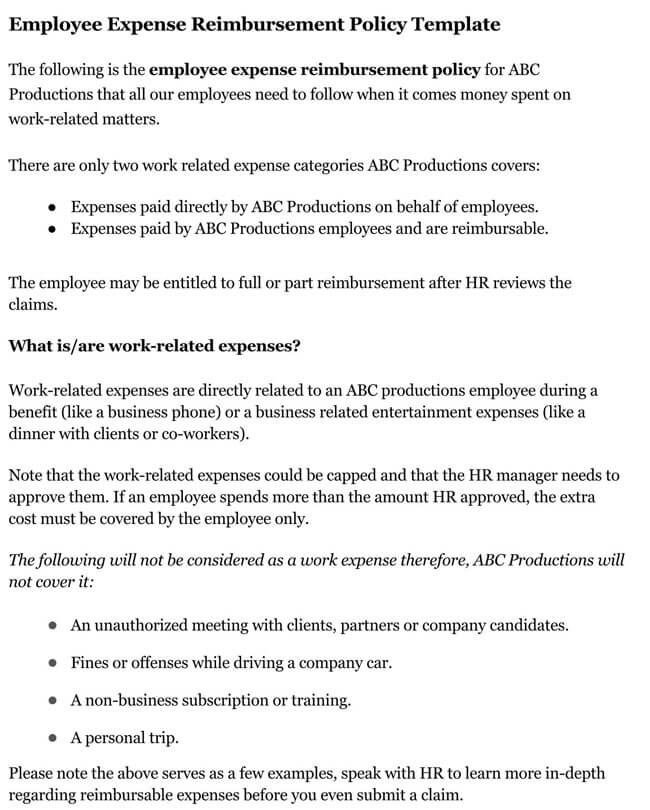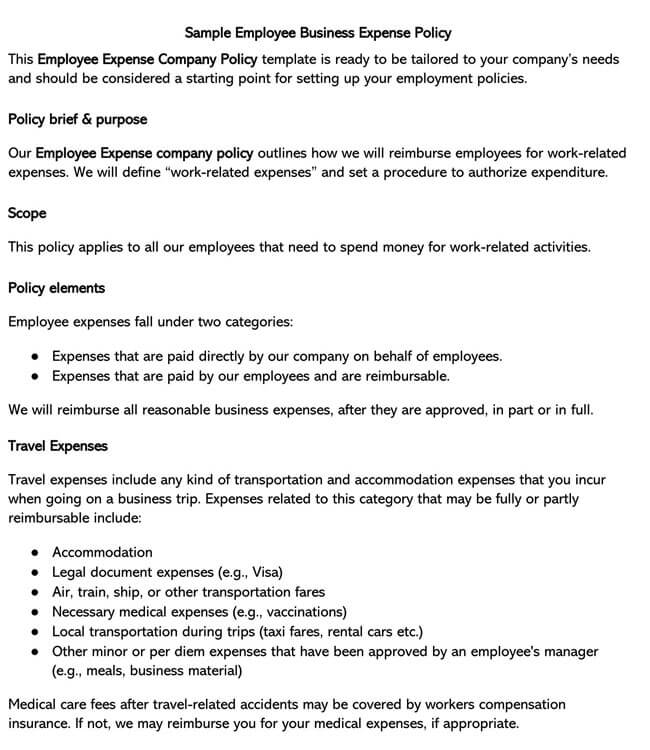Running a business can be expensive. As a business owner, you should know that expenses can always go beyond the operation costs if not properly managed. As your business grows, your employees may be tempted to spend on services that benefit the company. However, without setting limits, accounting for such expenses may be difficult. For this reason, every employer should always communicate to their employees the kind of expenses that can be reimbursed and those that cannot. This information can better be presented using an Expense Reimbursement Policy.
Expense Reimbursement Policy
Expense Reimbursement Policy is a guideline that dictates what kind of business-related expenses can be paid back by the employer. Ideally, every business-related expenses should be paid using corporate credit cards. However, there are some cases where an employee goes out of pocket to make purchases on behalf of the company using personal funds. These scenarios happen a lot in roles such as travel or even planning and management. When an employee uses his own money, they should adhere to the policy to be in a position for a refund/payback.
Other names
The following are other names a company may use to refer to Expense Reimbursement Policy:
- Employee Expense Compensation Policy
- Expense Reimbursement Policy for Employees
- Policy for Compensating Employee Expenses
- Policy for Expense Reimbursement
- Policy for Employee Expense Reimbursement
Download Free Templates
The rules of accounting can be complex for everyone. However, to manage your reimbursement expenditures more efficiently, feel free to download our free templates. Our templates are flexible; hence you can make relevant changes to suit your company preference.




Applicable laws
Ideally, there is no specific law applicable to the Policy. However, an individual company may choose to enforce laws on their expenditure regulations.
Importance of Having an Expense Reimbursement Policy
Having a solid policy brings lots of benefits to your company.
Let’s take a look at some of them:
Segregates reimbursable and non-reimbursable expenses
One of the top reasons why an employer would issue a policy is to help distinguish reimbursable expenses from the non-reimbursable ones. When the employees are made aware of the legitimate expenses they can incur on behalf of the company, it is easier to know what to buy and what not to.
Controlling costs
Other than letting the employee aware of the reimbursable expenses, the policy also helps in cost control. There are cases where an employee will want to claim more than the allocated budget. When employees don’t have a clear spending policy, they can intentionally overspend or engage in fraudulent activities. However, having the policy in place can help control costs and frauds.
Efficient workflow
Managing company expenses can be difficult. Therefore, having a well-stated policy helps the finance team to track and manage multiple employee expenditures. It brings all information around expenses and expense reimbursement under one roof. As such, the policy provides seamless expense reporting that makes financial management efficient.
Elements of Expense Reimbursement Policy
Knowing what to include in the policy can be challenging, especially if you are new in the sector. Typically, a standard policy is one that covers all essential elements for the company.
To ensure full compliance from your employees, an employment reimbursement policy should contain the following elements:
Reimbursable expenses
Depending on the nature of an organization or company, an employer may prefer a particular type of expenses to be part of its reimbursement policy.
Generally, the following are some types of expenses will qualify for reimbursements:
- Travel expenses- these include all expenses made to facilitate business trips such as accommodation, legal documents (visa), transportation fares, vaccinations, cabs, and other per diems.
- Conference and seminar fees.
- Office supplies and stationeries
- Computer software
Guidelines for requesting expense reimbursements
As an employer, you need to layout clear guidelines on how reimbursements should be requested. First, you need to instruct your employees to track their expenses by keeping every receipt of purchase. While paper receipts may sometimes look bulky or tedious to handle, there is digital software that can make the process even much simpler.
Also, you need to set a deadline for filing the expense reports. Once the expense reports have been presented to the financial team, they should be processed within the next 30 days. Lastly, the employer will decide whether to reimburse the employee out of pocket, direct bank deposit, or any other convenient payment method(s).
NB, Transaction receipts are very critical in this process as it shows proof of a given transaction, thereby preventing any related frauds. Therefore, always ensure your employees provide receipts anytime they present an expense report or reimbursement request.
Non-reimbursable expenses
Depending on the nature of your business, there are certain expenses that won’t qualify for reimbursement. Therefore, should the employee incur any expenses on them, the employer will not be held responsible.
Generally, the following are some of the common non-reimbursable expenses:
- Loss of personal property
- Penalties charged due to your recklessness
- Unauthorized flight upgrades, meals, or entertainment
- Any other expenses made on non-authorized persons such as spouses, friends, or children
- Buying personal items that do not conform to the company’s operations.
Implying an Expense Reimbursement Policy
Creating a policy can sometimes be confusing, especially for those doing it for the first time. If you want to do it effectively, proper documentation should be your utmost concern.
The following are some of the ways the employer can imply the reimbursement policy:
Distinct and specific policy
As an employer, the first thing you need to ensure is to make your policy clear and straightforward. Make good use of simple and easily understandable language to make everyone understand the guidelines.
Test it on employees
When introducing the policy to your team, the chances are that not everyone will fully comprehend its demands. While some will quickly get along, some are more likely to have challenges. Therefore, you need to first test the policy on a small representative sample before rolling it out to the entire workplace. The feedback you’ll receive from testing will enable you to know which parts are well understood and which ones are not. With such information, you can then simplify, adjust or explain areas with little comprehension.
Make it available
Once the employees have understood all the nitty-gritty of the new policy, you now need to make it easily available. Fortunately, the internet and intranet have made it possible to share information freely and extensively. Depending on your preference, you can share the policy document through the cloud-based drive, email, hard drives, or printed copies.
Include it in corporate travel policy
Generally, a corporate travel policy defines the rules and procedures an employee must follow when traveling for business purposes (s). When traveling on behalf of the company, the expenses will definitely be reimbursed. Therefore, to make the policy more accessible, be free to add it to your corporate travel policy.
Provide expense management tools
With the advancement of technology, there are a variety of expense management tools you can avail to your employees. A better example of tools you can use is travel and expense software. These tools make it easy and efficient for your team to collect and file receipts while traveling or purchasing on behalf of the company.
Ways to Avoid Expense Reimbursement Fraud
As mentioned above, the policy can help curb any fraudulent activity from happening.
Here are some of the useful tips that can help you out:
Ask for receipts
When an employer requests reimbursement, the employer/manager should always request the receipts of purchase. This is the only way to confirm or validate the expenses made on behalf of the company. If the employee doesn’t produce the receipts, then the employer can choose not to make the reimbursement.
Scrutinize receipts
Other than just being presented with the receipts, the employer should take their time to validate the receipts. Check whether the receipt is forged, or whether the purchase was necessary at that particular time. Also, investigate whether the purchase was business-related or personal.
Consequences for fraud
In your Expense reimbursement policy, you should clearly indicate consequences that follow should an employee violate any set rule(s). For instance, if an employee spends on non-business purchases, they won’t be reimbursed any amount. Also, if they overspend on business-related purchases, only the allowed amount will be reimbursed. Creating a prior consequence for fraud makes the employees aware hence cautious spending.
Use tools
You can use tools that help enforce the company’s spending policy. These may include a GPS Tracking system to calculate travel mileage payment authorization systems.
Access to virtual corporate cards
Unlike physical corporate cards, virtual cards make it easy to block fraudulent loopholes when purchasing items. The virtual corporate cards can sense and issue a warning to an employee attempting to make suspicious purchases/expenses.
Frequently Asked Questions
Expense reimbursements can only be practiced in the following states:
• California
• New York
• Illinois
• Iowa
• District of Columbia
• Massachusetts
• Pennsylvania and
• Montana
Yes. The employer can withhold reimbursement if your expenses aren’t eligible. However, some states have mandatory reimbursement laws that every employer should adhere to.
Yes. Volunteer expenses can be reimbursed. However, this should be done with a lot of caution. The volunteer should provide legitimate receipts with exact pricelists. Note that if any fraud is detected, it can compromise the trust and relationship with the employer.
Conclusion
An Expense Reimbursement Policy is among the most important documents an employee should be given at the start of his/her employment tenure. With this policy document, employees are able to make business-related purchases and wait for reimbursement. Also, employers can track any fraudulent activities from purchases made on behalf of their company.








